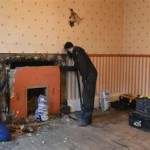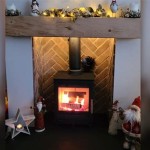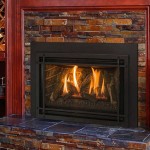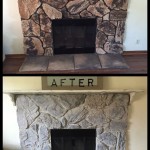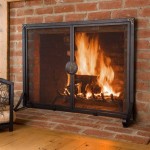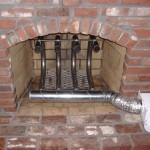Understanding the Rumford Fireplace Grate: Functionality and Design
The Rumford fireplace, originating in the late 18th century through the innovations of Count Rumford (Benjamin Thompson), is a fireplace design specifically engineered for improved efficiency and heat radiation. A key, and often overlooked, component in optimizing the performance of a Rumford fireplace is the grate. The Rumford fireplace grate, unlike a standard fireplace grate, is often tailored to the specific dimensions and design principles of the Rumford firebox. This article will examine the function, design considerations, and importance of the Rumford fireplace grate in maximizing combustion and heat output.
The primary purpose of any fireplace grate is to elevate the firewood above the hearth floor. This elevation serves several vital functions: it allows air to circulate beneath the wood, promoting more complete and efficient combustion; it provides a space for ash to accumulate, preventing it from smothering the fire; and it helps to direct radiant heat forward into the room. However, the significance of these functions is amplified within the context of a Rumford fireplace, where design intricacies demand a grate that complements the overall system rather than simply serving as an incidental accessory.
Optimizing Airflow for Efficient Combustion
One of the defining characteristics of a Rumford fireplace is its shallow firebox and angled side walls. This design is intended to maximize radiant heat reflection into the room. However, it also necessitates careful attention to airflow. A poorly designed grate can impede airflow, leading to incomplete combustion, increased smoke production, and reduced heat output. The Rumford fireplace grate, therefore, should be designed to promote a consistent and unimpeded flow of air around and through the firewood.
The design considerations related to airflow begin with the spacing between the grate bars. Wider spacing allows for greater airflow but can also allow smaller pieces of burning wood to fall through, potentially creating a safety hazard or hindering the fire’s progress. Narrower spacing, conversely, can restrict airflow, resulting in a smoldering, smoky fire. The ideal spacing is a balance that facilitates airflow without compromising safety or combustion efficiency. Furthermore, the overall height of the grate is crucial. A grate that is too low can become quickly buried in ash, effectively blocking airflow. A grate that is too high can reduce the amount of radiant heat reflected by the back wall of the firebox. Therefore, optimal grate height is crucial for the Rumford fireplace.
The arrangement of the grate bars is also important. Some Rumford fireplace grates feature a parallel bar design, while others employ a more complex pattern intended to create turbulence and improve air mixing. Regardless of the specific design, the primary goal is to ensure that air is supplied evenly to all parts of the fire. This uniformity of airflow is essential for consistent and complete combustion.
Radiant Heat Maximization
The hallmark of a Rumford fireplace is its ability to radiate a significant amount of heat into the room. This is achieved through the combination of a shallow firebox, angled side walls, and a tall, narrow opening. The fireplace grate plays a role in this process by positioning the fire in a way that maximizes the radiant heat reflection from the firebox walls. The grate should be positioned so that the fire is centered within the firebox, allowing the heat to be evenly distributed across the reflective surfaces.
The material of the grate also impacts radiant heat transfer. Cast iron is a common material for fireplace grates due to its durability and ability to absorb and radiate heat. However, some grates are made from steel, which also provides excellent heat resistance. The choice of material often depends on the specific design and aesthetic preferences of the homeowner.
The angle of the grate can also be modified to enhance radiant heat projection. Some Rumford fireplace grates are designed with a slight incline, directing the fire forward and upward towards the room. This incline helps to capture more of the radiant heat that would otherwise be lost up the chimney.
Durability and Material Considerations
A fireplace grate is subjected to intense heat and repeated thermal cycling. Therefore, the durability of the grate is paramount. The grate must be constructed from materials that can withstand high temperatures without warping, cracking, or corroding. As mentioned previously, cast iron and steel are the most common materials used in fireplace grate construction. Cast iron is known for its excellent heat retention and resistance to deformation at high temperatures. Steel, particularly high-carbon steel, offers similar properties and can be more cost-effective.
The thickness of the grate bars is another crucial factor in determining its longevity. Thicker bars are more resistant to bending and warping under the weight of the firewood and the intense heat of the fire. However, excessively thick bars can inhibit airflow, so a balance must be struck between durability and performance. The weld joints must also be robust and well-executed to prevent failure under stress. Poorly welded joints are often the weakest point of a fireplace grate and can lead to premature failure.
Regular maintenance can also extend the lifespan of a Rumford fireplace grate. This includes removing ash buildup, which can trap moisture and accelerate corrosion. Periodically inspecting the grate for signs of damage, such as cracks or warping, is also recommended. If damage is detected, the grate should be repaired or replaced to prevent further deterioration and ensure safe operation.
In summary, the Rumford fireplace grate is a vital component in optimizing the performance of a Rumford fireplace. Its design must consider airflow, radiant heat maximization, and durability to ensure efficient combustion, effective heat radiation, and long-lasting performance. A well-designed and properly maintained Rumford fireplace grate is an investment in both comfort and safety.
The proper selection of a Rumford fireplace grate should also consider the specific dimensions of the firebox to facilitate proper placement and functionality. A grate that is too large will not fit properly and may damage the firebox, while a grate that is too small will not provide adequate support for the firewood, potentially impacting combustion efficiency and safety.
Ultimately, the Rumford fireplace grate embodies the principles of efficient design and functionality. It is a small but essential component that plays a significant role in the overall performance and enjoyment of a Rumford fireplace. Its selection should be approached with careful consideration of the factors outlined above to ensure optimal results.

Tr 7 Rumford Fireplace Grate Wall Of Fire

Tr 9 Rumford Fireplace Grate Wall Of Fire

How To Measure Your Fireplace
Tr 7 Pineapple Rumford Fireplace Grate Wall Of Fire

Rumford Fireplace Kevin Lee Jacobs
M 4 Fireplace Grate 16 Wide Wall Of Fire

Building A Fire

Why Should I Be Cautious Before Use An Old Homes Fireplace Opening

Building A Fire

Icc Renaissance Rumford 1500 Woodland Stoves Fireplaces


